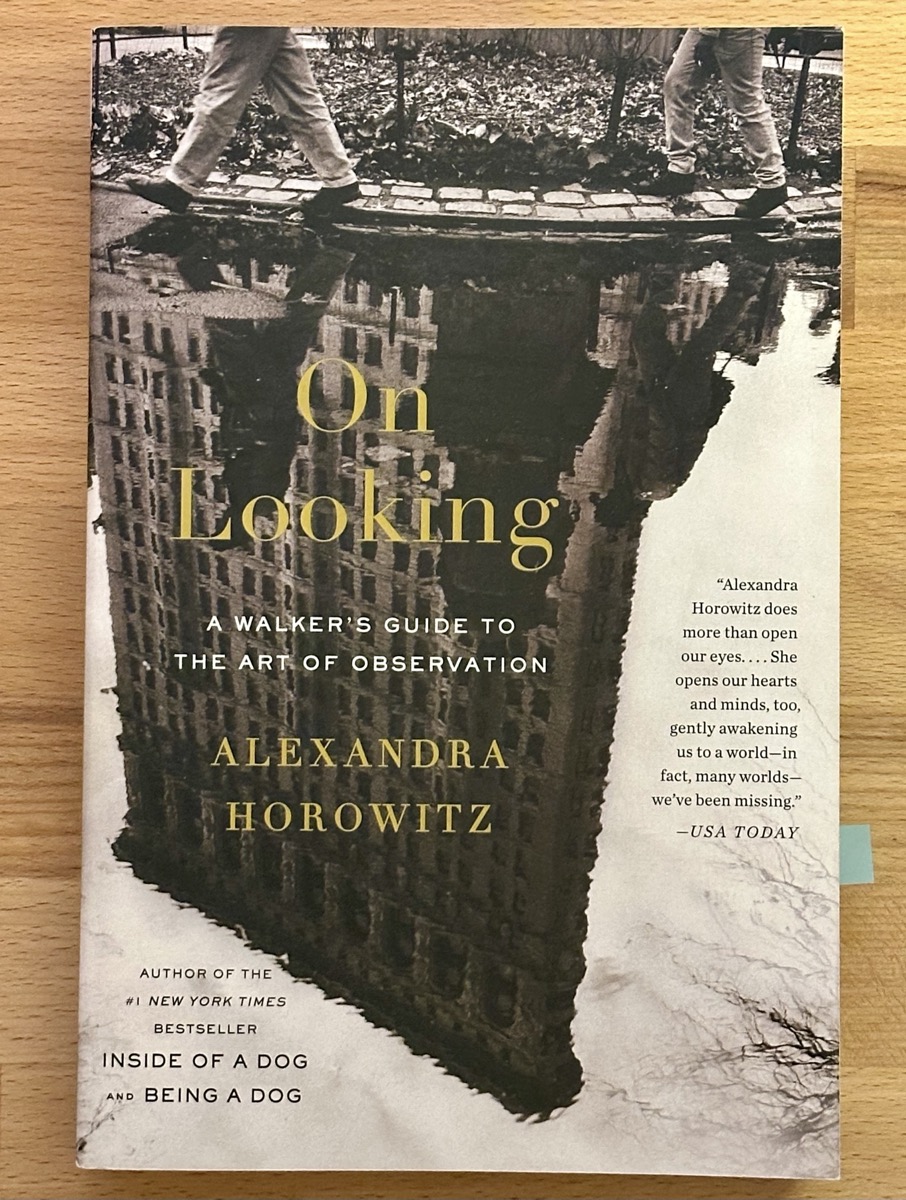justing.net
On Looking by Horowitz, part 1
This is the first part of my raw reading notes from the book. See also the second part, and the final part.
“On Looking, a walker’s guide to the art of observation” by Alexandra Horowitz, 2013
I am read the Scribner paperback, 1st ed. 2014.

This is the 15th book that I’ve read this year.
Introduction
- 3: déformation professionnelle, French. What you see is biased by your profession and professional experience.
Chapter 1
Ch 1 is from the child’s point of view. The point is that as we age we learn1 what is relevant and what is not. The toddler doesn’t have this filter, so they attend to everything that they find interesting.2 Everything is novel to them, so everything is interesting.
- 19: You can observe a lot by watching. -Yogi Berra
- 23: The new brains that infants have may not yet have learned to separate the sensorial experiences into separate categories. Research suggests that they are synesthesiacs, experiencing the world through crossed wires: a stuffy is mixed up with whisper, or the color green has a distinct flavor.
- 23: Heinz Werner called this synthesis of senses the “sensorium commune”. A primordial way of experiencing the world, pre-knowledge and pre-categorization.
- 26: “admire the unlovely”
Chapter 2
Ch2 is about the stones used on city buildings and the traces that they contain.
- 41: To find new things, take the path you took yesterday. -John Burroughs
Chapter 3
Ch3 is about lettering.
- 57: To see is to forget the name of the thing one sees. -Paul Valéry
- 58: “…our world is a linguistic one, fashioned in and then described with language.” This is a theme that Horowitz regularly comments on: we notice what we are primed to. In this case the naming of things may blind us to the details, differences, and sometimes new thing that is before us.
- 59: Surely comment about owning hundreds of dictionaries is hyperbole. I own a preposterous number of dictionaries yet I can count them all and still have fingers left over. Is this an excuse for me to buy more?
I admit that it was around this point that I wavered a bit. Maybe this book is not for me after all. I’m glad that I didn’t give up and continued on to the next chapter.
Chapter 4
Ch 4 is about social space. Public and private spaces, and private spaces that are open to visitors. Personal space around individuals. The “fourth dimension,” or fifth if I were numbering it (but it’s the fourth chapter, so I get it). In this dimension, people become possibilities for interaction instead of the mere obstacles that they sometimes are when we confine our thinking to only three dimensions. Of the chapters so far, this one has been the most electric to me.
- 75: “celebrate the ordinary”
- 76: The visual strategy of children, if it is a strategy since they don’t have the experience to do differently, is to see the world and not know the name or function of all the things that they are looking at. This is a creatively free position to be in since magnetic attraction of prior ideas do not get in the way of considering the options. See also p57.
- 77: The ordinary, upon close or long inspection, may become strange, odd, unfamiliar even. Try it.
- 77: Jakob von Uexküll: “The best way to find out that no two human Umwelten [world-views] are the same is to have yourself led through unknown territory by someone familiar with it. Your guid unerringly follows paths that you cannot see.”
- 78: “walking around the block entered a fourth dimension.” I had a few funny reactions to this one. Isn’t time the fourth dimension? Or maybe it’s the zeroth, which is good because it is often unconsidered as a dimension. Just now, how many fourth dimensions are there? Maybe our numbering scheme shifts there. Etc. Still, I appreciate the additional layers to consider here, visio-spatial is not the limit of our domain.
- 80: walking is a fundamentally social activity.
- 80: Heini’s personal zones of social contact. Those we are intimate with at whisper distance; the social zone, conversation distance; and formal interactions where we might use our outdoor voices.
- 84: Noticing that we are gazed at by another person causes our parasympathetic nervous system to enter a heightened state of readiness, similar to being looked at by an apex predator but less so.
- 87: The social dimension is not hard edged, but has a smoothly variable field with “an infinitely explorable openness.”
- 89: An exercise in “divergent thinking:” find more and more elaborate uses for everyday things. Or unusual uses, or off label, or improbable.
Probably the key insight here is (89): “Objects and people on [the] route become possibilities for interaction, rather than decoration or obstruction….”
This chapter was quite interesting to me. Filled with useful ideas and different ways of thinking about things. Permissions and suggestions.
That’s it for the first portion of the book. One thing that I was surprised to discover is that all the copies at the library are checked out, and there are several holds. This is true for both the physical copies and the ebooks. I’m not really sure why that is the case, especially since it’s not that new of a book.
To Reply: Email me about what you notice.
Posted: in Reading.
Other categories: book-notes.
Back references: none.
Tags that connect: [[Horowitz]] On Looking by Horowitz, part 3, On Looking by Horowitz, part 2, An Imperfect Library of Noticing, Latest Now Page Updates, Latest New Now, Update to Now; [[On Looking]] On Looking by Horowitz, part 3, On Looking by Horowitz, part 2, An Imperfect Library of Noticing, Latest Now Page Updates, Latest New Now, Update to Now.
Tags only on this post: filtering, lettering, synesthesia.